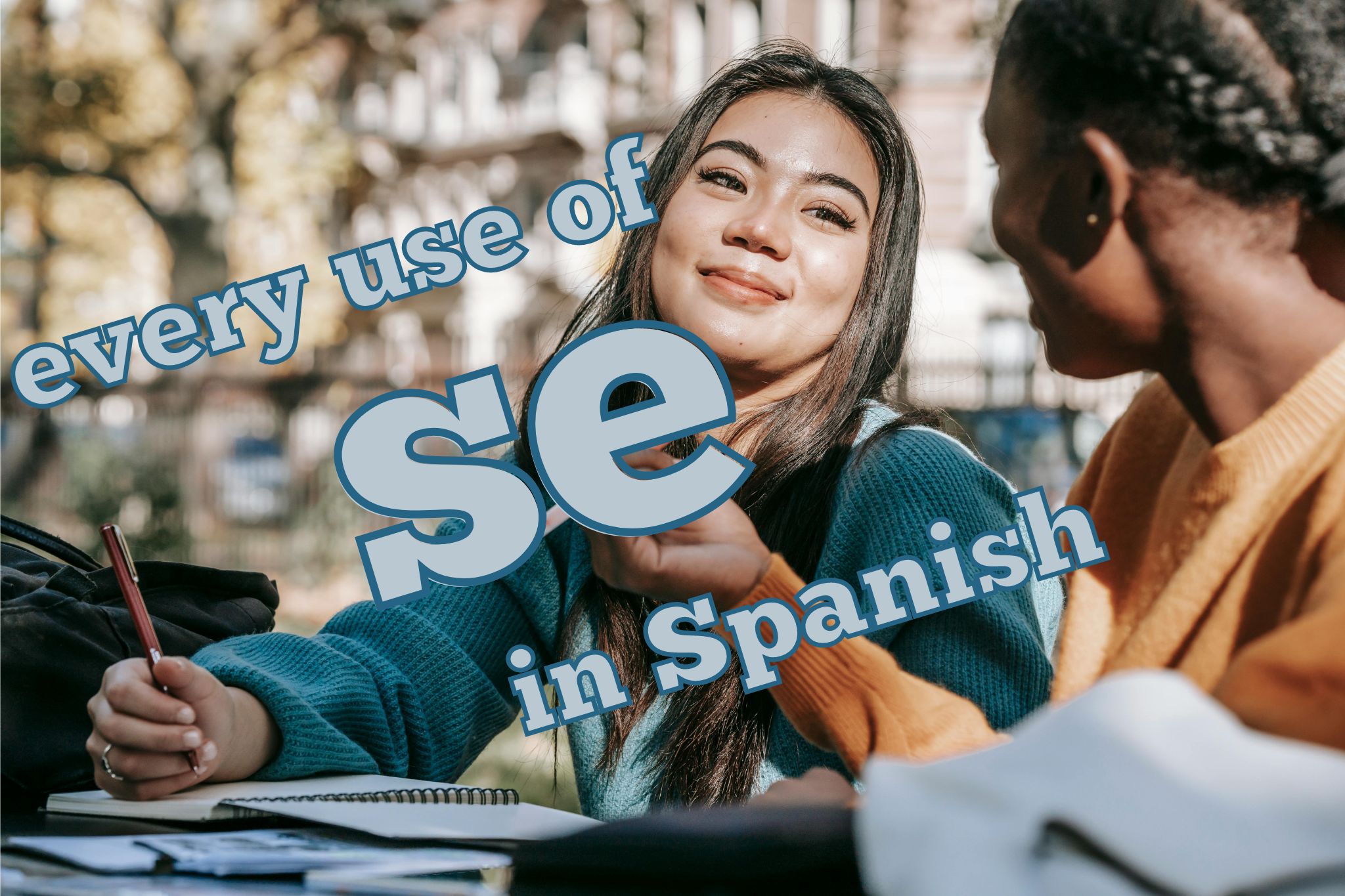Se in Spanish: A comprehensive guide to all the uses of Se in Spanish

Get our free email course, Shortcut to Conversational.
Have conversations faster, understand people when they speak fast, and other tested tips to learn faster.
More infoThe pronoun se is a complex and versatile element of Spanish grammar, taking on various grammatical functions. Mastering the diverse uses of se in Spanish is essential for learners seeking fluency and precision in their communication.
In this comprehensive guide, we will explore the seven primary roles of se in Spanish, presenting each usage in straightforward terms and providing illustrative examples. Whether you’re just beginning to grasp reflexive verbs or delving into the intricacies of passive constructions, today’s post will clarify the various functions of se in the Spanish language.
Review: Spanish personal pronouns
Before we get into the different uses of se in Spanish, let’s just take a moment to review all of the Spanish personal pronouns. Se usually acts as a reflexive pronoun, in many different guises that we’ll see throughout the next sections. Se can also sometimes be an indirect object pronoun. We’ll refer back to the other groups of Spanish personal pronouns in several of our sections below, as well.
| Subject pronouns, Spanish | Direct object pronouns, Spanish | Indirect object pronouns, Spanish | Reflexive pronouns, Spanish |
| yo | me | me | me |
| tú | te | te | te |
| él, ella, usted | lo, la | le (se) | se |
| nosotros, nosotras | nos | nos | nos |
| vosotros, vosotras | os | os | os |
| ellos, ellas, ustedes | los, las | les (se) | se |
Reflexive Se
Se is the third-person reflexive pronoun in both singular and plural, appearing with a variety of verbs when they’re used reflexively. For verbs with both reflexive and non-reflexive forms, the reflexive form is also known as the pronominal form.
Reflexive verbs in Spanish can be broken down into three main groups, so we’ll see each one in its own section here. The reflexive pronoun se in Spanish is also used in other contexts than with reflexive verbs; we’ll move on to those uses in subsequent sections.
Strictly reflexive verbs
For some verbs, se is an indivisible part of the verb. When conjugated to a third-person subject, these verbs always take the reflexive pronoun se. We can recognize reflexive verbs because their infinitive forms end in -se.
- Luisa se queja todo el tiempo. – Luisa complains all the time. (quejarse – to complain)
- Andrés se atrevió a cuestionarme. – Andres dared to question me. (atreverse – to dare)
- ¿Ustedes se arrepienten de haberle contado sobre eso? – Do you regret having told her about it? (arrepentirse – to regret)
We have a number of posts that compare strictly reflexive verbs to their non-reflexive counterparts. To see the distinctions between each, check out our posts on llevar vs llevarse, olvidar vs olividarse, recordar vs acordarse, quedar vs quedarse, ir vs irse, sentir vs sentirse, encontrar vs encontrarse, and comer vs comerse.
Optionally reflexive verbs
Many Spanish learners are familiar with a set of verbs for self-care activities like washing oneself, that are often used with the reflexive pronouns. Unlike the strictly reflexive verbs we saw above, these reflexive verbs can also be used non-reflexively if the subject of the sentence applies the action to someone else. In many contexts, however, the subject and the object of the verb is the same, so we use reflexive pronouns.
Again, se is the third-person reflexive pronoun, so it’s used with these reflexive verbs whenever the subject is él, ella, usted, ellos, ellas, or ustedes.
- Mi mamá se maquilla para ir a trabajar. – My mom does her makeup to go to work.
- Las niñas se peinan el cabello. – The girls comb their hair.
- Ustedes se lavan las manos con agua y jabón. – You guys wash your hands with water and soap.
Reflexive Se with non-reflexive verbs
Some actions aren’t normally performed on oneself, but if they can be, then we can use reflexive pronouns rather than indirect object pronouns. The equivalents in English always end in -self or -selves.
An example would be that I buy myself one thing, and I buy him something else. I don’t buy me something and buy himself something else, though he could buy himself something and buy me something instead! (Me and him are indirect object pronouns here, while myself and himself are reflexive pronouns.)
The same rule applies in Spanish, so when a third-person subject does an action on or for themself, we use the third-person reflexive pronoun se.
- Mariana se prepara un batido. – Mariana makes herself a smoothie.
- Los niños se sirven vasos de zumo. – The children serve themselves glasses of juice.
- Ustedes se compran helados cada vez que vienen aquí. – You guys buy yourselves ice creams every time you come here.
Reciprocal se
When two or more subjects perform an action on each other, we use the reciprocal se in Spanish. The equivalent in English is to say each other or one another, indicating mutual or reciprocal actions between the subjects involved.
In either language, this construction usually involves two or more distinct subjects. It still works well enough in Spanish if a single subject implies multiple individuals, however, such as “the team” or “the crowd.”
- Las dos hermanas se escriben cartas todos los días. – The two sisters write each other letters every day.
- Luis y Mariana se saludaron con un apretón de manos. – Luis and Mariana greeted each other with a handshake.
- El equipo es muy colaborador y se ayuda continuamente. – The team is very collaborative and [they] help each other all the time.
Middle voice se
The middle voice is part of the spectrum of agency in Spanish. We use it to describe actions where the subject experiences a change without intending to. This construction is also known as the accidental reflexive.
In middle voice constructions, what would have been the direct object of a transitive verb instead becomes the subject. The verb becomes an intransitive pronominal verb by matching the conjugation and the reflexive pronoun to this subject.
We use the reflexive pronoun se in Spanish for any third-person subjects in this middle voice construction; the same construction can be used with other subjects as well, with their corresponding reflexive pronouns and verb conjugations.
- La tostada se quemó. – The toast got burned.
- Me parece que se abrió la puerta. – I think the door opened.
- Anoche llovió tanto que se inundó el ayuntamiento. – Last night it rained so much that the City Hall got flooded.
- Las naranjas se cayeron de la mesa. – The oranges fell off of the table.
If the accidental action described using the middle voice has affected someone, we can indicate this by adding an additional indirect object pronoun after the reflexive pronoun. We explain this construction in more detail in our post on the accidental se.
- A Andrea se le cayó el teléfono de la ventana. – Andrea’s phone fell out the window.
- Las arepas se nos quemaron. Mejor hagamos sándwiches. – Our arepas got burned. Let’s just make sandwiches.
- Se me dañó la computadora ayer. – My computer crashed yesterday.
Reflexive Se in the passive voice
The passive voice is used to describe an action that happens to a subject, by placing the emphasis on the subject rather than on the actor.
When such a subject is an inanimate object, we can use the reflexive pronoun se in Spanish to form the passive construction. The verb needs to be transitive, since the object of its action is the passive sentence’s subject. The verb is conjugated in the third person, either singular or plural to reflect this subject.
We go into a lot more detail on this form of speech in our post on the passive voice in Spanish.
- Copias de llaves se sacan. – Copies of keys are made.
- Se celebrará una reunion por semana. – One meeting will be held per week.
- Se han analizado las pruebas. – The evidence has been analyzed.
The impersonal Se
This construction is used to make general statements or actions without attributing them to any specific actor. We don’t mention a subject that the verb is conjugated to, leaving the actor as a vague or unspecified entity. Indeed, here the reflexive pronoun se serves as the impersonal subject for the verb. The verb is always conjugated in third-person singular.
In these cases, our Spanish se essentially serves as a marker for impersonal expressions, devoid of reference to any particular individual(s) who might be carrying out the action.
We can use the impersonal se with intransitive verbs to just say that the action happens. If it’s used with transitive verbs whose direct object is animate, we need to introduce the object with the personal a.
- Se patina en la calle cada domingo durante los ciclovías. – There’s skating in the street every Sunday during the ciclovías.
- Se entrevistó a los testigos. – Witnesses were interviewed.
- Se come bien aquí. – You eat well here. – The food here is good.
- Se vende trigo. – Wheat for sale. – Wheat is being sold.
We go into a lot more detail on this use of se in Spanish in our post on the impersonal se.
Emphatic se
This use of se in Spanish goes by several names, including emphatic se, delimiting se, aspectual se, and intensive se.
The emphatic se is commonly utilized with verbs related to consumption or ingestion, such as comer, beber, or fumar, and with other verbs related to the senses like leer, oír, or conocer. When such verbs are followed by a direct object specifying a quantity, we can add an optional reflexive pronoun to really emphasize the quantity. The purpose of this emphatic pronoun is to indicate that the object was consumed in its entirety.
An English example of this grammatical peculiarity is repeated multiple times in the classic ‘90s track Peaches, by The Presidents of the United States of America:
- Me mudo al campo, me voy a comer muchos duraznos. – I’m movin’ to the country, I’m gonna eat me a lot of peaches.
This construction is a lot more common in Spanish. We use the reflexive pronoun se when we have a third-person subject, which is our emphatic se in Spanish.
- Luis se comió todo el pastel. – Luis ate the whole cake.
- Los niños se bebieron todo el jugo. – The kids drank all the juice.
- ¿Usted se leyó todo el libro o aún no? – Did you read the whole book, or not yet?
Indirect object pronoun Se
When a Spanish sentence contains both an indirect and a direct object pronoun, the two of them are placed together in that order. In some sentence structures the two are attached directly to the end of a verb, while in others they appear as two separate words before the verb.
We’ll italicize the direct objects in these example sentences to keep them clear, while bolding the indirect objects.
- ¿Tienes las llaves? Por favor pásamelas. / No, Julia las tiene. Se las di cuando nos fuimos. – Do you have the keys? Please pass me them. / No, Julia has them. I gave her them when we left.
In such sentences with direct and indirect object pronouns together, the third-person indirect object pronoun (normally le or les) becomes se if it’s with a third-person direct object pronoun (lo, la, los, or las). This occurs to avoid awkward pronunciations, so instead of “le lo” or “les las,” for example, we say “se lo” and “se las.”
- ¿Te parece lindo este vestido? Creo que se lo regalaré a mi hermana. – Do you think this dress is nice? I think I’ll give it to my sister.
- No encuentro mis llaves, creo que Diana se las llevó. – I can’t find my keys, I think Diana took them.
- No veo las bicicletas, ¿ustedes se las llevaron? – I don’t see the bikes, did you take them?
Bonus: Sé in Spanish
So far we’ve kept our focus on the Spanish pronoun se, whether used as an indirect object pronoun or as a reflexive pronoun in many of its grammatical contexts. But what about the accented word sé?
Remember that accents change words entirely, so se and sé in Spanish are very distinct from each other! While the unaccented se is always a pronoun, as we’ve explored thus far in this post, the accented sé is a conjugated form of a couple of common verbs: saber and ser.
For the essential Spanish verb ser, meaning to be, the second-person singular conjugation in the imperative mood is sé. In other words, this is the command form for tú, meaning essentially be!. To review all forms of this verb, see our post on ser conjugation. If you want to compare the use of ser with the other Spanish verb for to be, see our post on ser vs estar. For a lesson on using the imperative mood with tú, see our post on informal commands in Spanish.
For the common Spanish verb saber, meaning to know, the first-person singular conjugation in the simple present tense is yo sé, meaning simply I know. To see the differences between this verb and the other common Spanish verb meaning to know, see our post on saber vs conocer.
- Sé amable con tu hermana. – Be nice to your sister.
- Sé un mejor novio, y tal vez ella no te deje. – Be a better boyfriend, and maybe she won’t leave you.
- No sé si tengo tiempo para ir. – I don’t know if I have time to go.
- Yo sé cambiar una llanta. – I know how to change a tire.
Sé and se offer us just one example of Spanish words with identical pronunciations, but with very different meanings. We have a couple of specific posts on this phenomenon, including one where conjugated verbs are identical to other words, and another of words with identical pronunciations but different spellings.
Conclusion: Se in Spanish
Alright, great job! We’ve just taken a big tour of all the different possible uses of the little word se in Spanish. Let’s just do a quick recap before we go for a rapid review of when to use se in Spanish.
First we saw that se is always a pronoun, with a clear list of all the Spanish personal pronouns to see what roles it can play.
In most cases, se is a reflexive pronoun, although this role can come in many guises depending on our specific sentence structures. Beyond the standard set of reflexive verbs, we saw how the reflexive pronoun se in Spanish can appear in many other grammatical contexts:
- As the reciprocal se, it helps us describe actions that multiple actors apply to each other.
- In the middle voice, the accidental se allows us to describe actions that happen to something unintentionally.
- In the passive voice we use se to say that something happened, without placing the emphasis on the actor.
- The impersonal se is used to make general statements about actions.
- The intensive or emphatic se allows us to really emphasize a quantity.
Se in Spanish can also appear as an indirect object pronoun, but only in constructions where indirect and direct object pronouns appear together in a sentence. In this context, se replaces the indirect object pronoun le or les if the adjacent direct object pronoun also begins with the letter l.
Finally, we made the distinction between se vs sé in Spanish. This accented sé is a conjugated form of two common verbs: ser and saber. With ser, sé! is the second-person singular command form, while with saber, yo sé is the first-person singular conjugation in the present tense, meaning I know.
We provided a ton of examples throughout our lesson, as well as links to detailed posts on each of the different uses of se in Spanish that we presented here. Whether navigating reflexive verbs or understanding the intricacies of impersonal expressions, our goal was to equip you with a deeper understanding of the multifaceted nature of se in the Spanish language. By recognizing how and when to use se in Spanish in its various contexts, you can enhance your proficiency in Spanish and express yourself with greater clarity and accuracy!



